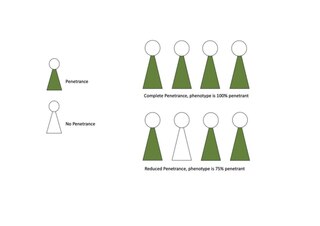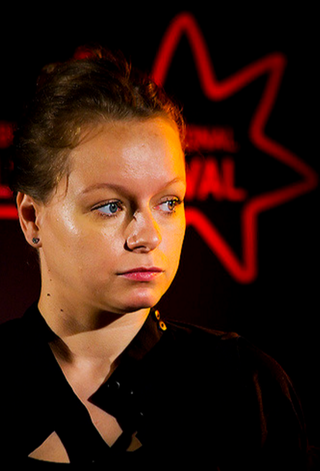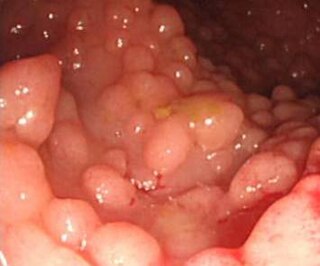
A tumor suppressor gene (TSG), or anti-oncogene, is a gene that regulates a cell during cell division and replication. If the cell grows uncontrollably, it will result in cancer. When a tumor suppressor gene is mutated, it results in a loss or reduction in its function. In combination with other genetic mutations, this could allow the cell to grow abnormally. The loss of function for these genes may be even more significant in the development of human cancers, compared to the activation of oncogenes.

Penetrance in genetics is the proportion of individuals carrying a particular variant of a gene (genotype) that also expresses an associated trait (phenotype). In medical genetics, the penetrance of a disease-causing mutation is the proportion of individuals with the mutation that exhibit clinical symptoms among all individuals with such mutation. For example: If a mutation in the gene responsible for a particular autosomal dominant disorder has 75% penetrance, then 75% of those with the mutation will go on to develop the disease, showing its phenotype, whereas 25% will not.

Breast cancer type 1 susceptibility protein is a protein that in humans is encoded by the BRCA1 gene. Orthologs are common in other vertebrate species, whereas invertebrate genomes may encode a more distantly related gene. BRCA1 is a human tumor suppressor gene and is responsible for repairing DNA.

Samantha Jane Morton is an English actress and director. She is known for her work in independent film with dark and tragic themes, in particular period dramas and is the recipient of numerous accolades, including the BAFTA Fellowship, a BAFTA Award, a Golden Globe Award, as well as nominations for two Academy Awards, a Primetime Emmy Award, and a Screen Actors Guild Award.
Malignant transformation is the process by which cells acquire the properties of cancer. This may occur as a primary process in normal tissue, or secondarily as malignant degeneration of a previously existing benign tumor.

Mary-Claire King is an American geneticist. She was the first to show that breast cancer can be inherited due to mutations in the gene she called BRCA1. She studies human genetics and is particularly interested in genetic heterogeneity and complex traits. She studies the interaction of genetics and environmental influences and their effects on human conditions such as breast and ovarian cancer, inherited deafness, schizophrenia, HIV, systemic lupus erythematosus and rheumatoid arthritis. She has been the American Cancer Society Professor of the Department of Genome Sciences and of Medical Genetics in the Department of Medicine at the University of Washington since 1995.

Myriad Genetics, Inc. is an American genetic testing and precision medicine company based in Salt Lake City, Utah, United States. Myriad employs a number of proprietary technologies that permit doctors and patients to understand the genetic basis of human disease and the role that genes play in the onset, progression and treatment of disease. This information is used to guide the development of new products that assess an individual's risk for developing disease later in life, identify a patient's likelihood of responding to a particular drug therapy, assess a patient's risk of disease progression and disease recurrence, and measure disease activity.
The Komen Brinker Award for Scientific Distinction was established by Susan G. Komen for the Cure in 1992 to recognize leading scientists for their significant work in advancing research concepts or clinical application in the fields of breast cancer research, screening or treatment.

Hereditary breast–ovarian cancer syndromes (HBOC) are cancer syndromes that produce higher than normal levels of breast cancer, ovarian cancer and additional cancers in genetically related families. It accounts for 90% of the hereditary cancers. The hereditary factors may be proven or suspected to cause the pattern of breast and ovarian cancer occurrences in the family. The name HBOC may be misleading because it implies that this genetic susceptibility to cancer is mainly in women. In reality, both sexes have the same rates of gene mutations and HBOC can predispose to other cancers including prostate cancer and pancreatic cancer. For this reason, the term "King syndrome" has recently come into use. The new name references Mary-Claire King who identified the genes BRCA1 and BRCA2.

Steven Bernstein, ASC, DGA, WGA is an American cinematographer, director, screenwriter and author. In 1992 he won the Best Artistic Contribution Award at the Tokyo International Film Festival for Like Water for Chocolate alongside Emmanuel Lubezki. He also won the Cannes Golden Lion for his work in commercials. His book Film Production has been translated into several languages and at one time was the bestselling textbook about film making. Bernstein was a 2014 ASC nominee for the Outstanding Achievement in Cinematography in One-Hour Episodic Television Series Award for his work on Magic City. Bernstein is a regular contributor to SonyCine Magazine where he writes articles on various aspects of filmmaking. Bernstein is a regular subject matter expert for articles about screenwriting and filmmaking for Adobe creative hub.
Genetic heterogeneity occurs through the production of single or similar phenotypes through different genetic mechanisms. There are two types of genetic heterogeneity: allelic heterogeneity, which occurs when a similar phenotype is produced by different alleles within the same gene; and locus heterogeneity, which occurs when a similar phenotype is produced by mutations at different loci.

A BRCA mutation is a mutation in either of the BRCA1 and BRCA2 genes, which are tumour suppressor genes. Hundreds of different types of mutations in these genes have been identified, some of which have been determined to be harmful, while others have no proven impact. Harmful mutations in these genes may produce a hereditary breast–ovarian cancer syndrome in affected persons. Only 5–10% of breast cancer cases in women are attributed to BRCA1 and BRCA2 mutations, but the impact on women with the gene mutation is more profound. Women with harmful mutations in either BRCA1 or BRCA2 have a risk of breast cancer that is about five times the normal risk, and a risk of ovarian cancer that is about ten to thirty times normal. The risk of breast and ovarian cancer is higher for women with a high-risk BRCA1 mutation than with a BRCA2 mutation. Having a high-risk mutation does not guarantee that the woman will develop any type of cancer, or imply that any cancer that appears was actually caused by the mutation, rather than some other factor.

In the Family is a 2008 documentary film, produced by Kartemquin Films, about predicting breast and ovarian cancer and the choices women make when they are faced with the dangers of a possible life-threatening disease. The film's director, Joanna Rudnick, tests positive for the familial BRCA mutation that increases her chances of developing breast cancer by 60%. Faced with these odds, Rudnick must examine her choices of possibly taking her chances or possibly having her breasts and ovaries removed.

A hereditary cancer syndrome is a genetic disorder in which inherited genetic mutations in one or more genes predispose the affected individuals to the development of cancer and may also cause early onset of these cancers. Hereditary cancer syndromes often show not only a high lifetime risk of developing cancer, but also the development of multiple independent primary tumors.
Henry Thompson Lynch was an American physician noted for his discovery of familial susceptibility to certain kinds of cancer and his research into genetic links to cancer.

Jórunn Erla Eyfjörð is an Icelandic molecular biologist and professor emerita at the Faculty of Medicine of the University of Iceland. She is known for her research on breast cancer genetics.
Joan H. Marks was an American educator and genetic counseling advocate. She wrote several papers in support of the then-burgeoning field of genetic counseling and was the longest-serving director of Sarah Lawrence College's Human Genetic graduate program, the first of its kind in the United States.

Kelly A. Metcalfe is a Canadian scientist and a professor at the University of Toronto and at Women's College Hospital. Her work's focus is on understanding the clinical and psychosocial implications of genetic testing for BRCA gene mutations in women, men and their families.
DNA: The Story of Life is a four-part Channel 4 documentary series on the discovery of DNA, broadcast in 2003.

Breast and ovarian cancer does not necessarily imply that both cancers occur at the same time, but rather that getting one cancer would lead to the development of the other within a few years. Women with a history of breast cancer have a higher chance of developing ovarian cancer, vice versa.














